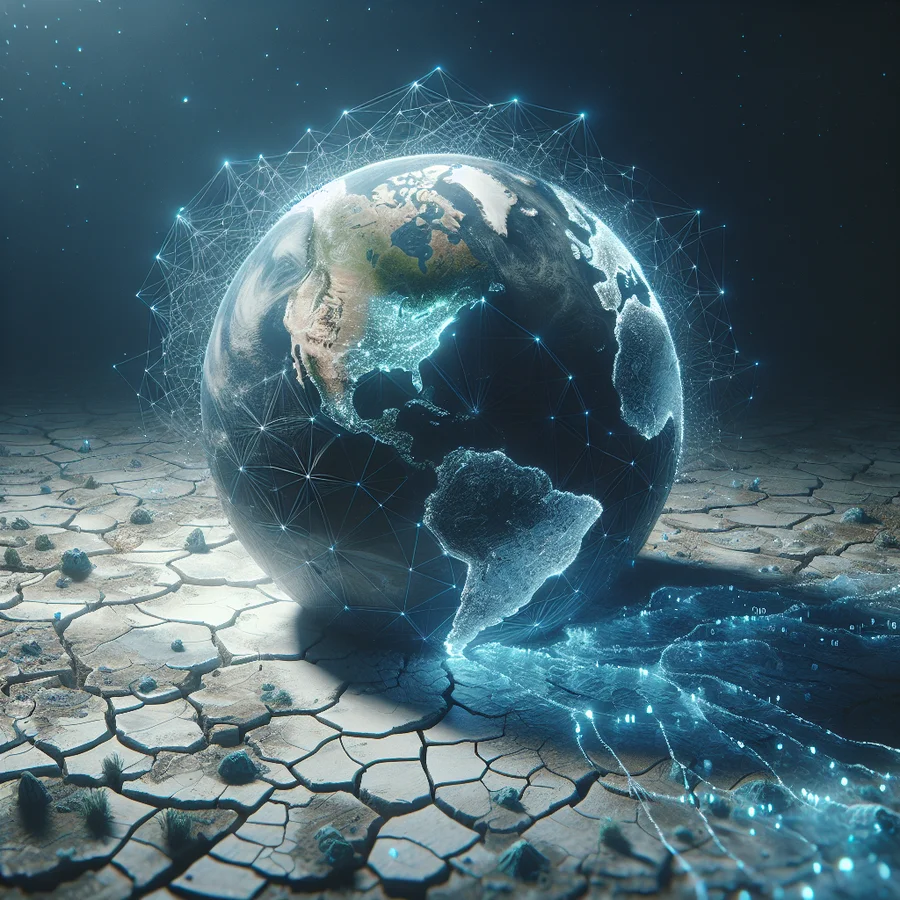AI in Climate Change: Analyzing Data and Predicting Trends
Climate change is a global challenge. It demands innovative solutions. Artificial intelligence (AI) offers powerful tools. These tools can analyze data and predict trends. This guide explores how AI helps us understand and combat climate change.
We will explore how AI is used to analyze climate data, predict future trends, and develop mitigation strategies. We’ll also discuss the challenges and opportunities of using AI in this critical field. Our aim is to provide a clear understanding of AI’s role in creating a more sustainable future.
Understanding the Role of AI in Climate Change
AI is transforming how we approach climate change. It provides the ability to process vast amounts of data. This data comes from various sources. These sources include satellites, sensors, and climate models. AI algorithms can identify patterns and predict future trends. This helps us make informed decisions and take effective action.
AI’s capabilities extend beyond just data analysis. It also helps in optimizing energy consumption, improving agriculture practices, and managing natural resources. By leveraging AI, we can develop more sustainable solutions and mitigate the impacts of climate change.
Analyzing Climate Data with AI
Climate data is complex and extensive. Analyzing it requires advanced tools. AI excels at processing and interpreting this data. It helps us understand the underlying patterns and trends. This understanding is crucial for making accurate predictions and informed decisions.
The Power of Machine Learning in Climate Data Analysis
Machine learning (ML) is a subset of AI. It focuses on algorithms that learn from data. These algorithms improve their performance over time. ML is particularly useful for analyzing climate data. It can identify complex relationships and predict future trends. ML helps us understand the impact of various factors on the climate.
For example, ML algorithms can analyze satellite images to monitor deforestation. They can also predict the impact of rising sea levels on coastal communities. By leveraging ML, we can gain valuable insights into the dynamics of climate change.
Using AI to Predict Climate Change Trends
Predicting future climate trends is essential for effective planning. AI algorithms can analyze historical data and current trends. This analysis helps us forecast future climate scenarios. These predictions inform policy decisions and mitigation strategies.
AI models can predict changes in temperature, precipitation, and sea levels. They can also forecast the frequency and intensity of extreme weather events. By understanding these trends, we can prepare for the impacts of climate change and develop resilient communities.
Specific Applications of AI in Climate Change Mitigation
AI offers a wide range of applications in mitigating climate change. These applications span various sectors, including energy, transportation, and agriculture. By leveraging AI, we can develop innovative solutions and reduce our carbon footprint.
- Energy Efficiency: AI can optimize energy consumption in buildings and industries. It analyzes energy usage patterns and adjusts settings to minimize waste.
- Renewable Energy: AI can forecast the availability of renewable energy sources. This helps in integrating them into the power grid.
- Sustainable Agriculture: AI can optimize farming practices. This reduces water usage and minimizes the use of fertilizers and pesticides.
These are just a few examples of how AI can contribute to climate change mitigation. By continuing to innovate and explore new applications, we can unlock even greater potential.
AI-Enabled Strategies for Climate Change Adaptation
Climate change adaptation involves adjusting to the current and future effects of climate change. AI plays a crucial role in developing and implementing effective adaptation strategies. It helps us protect communities, infrastructure, and businesses from the impacts of climate change.
Protecting Communities with AI
AI can help protect communities from climate-related hazards. It identifies vulnerable areas and develops targeted adaptation plans. AI-powered early warning systems can alert communities to impending disasters. This provides crucial time to prepare and evacuate.
For instance, AI can analyze satellite imagery to identify areas at risk of flooding or erosion due to sea-level rise. This information can be used to develop targeted adaptation strategies, such as building sea walls or relocating vulnerable infrastructure.
Safeguarding Infrastructure with AI
Infrastructure is vulnerable to the impacts of climate change. AI can help safeguard infrastructure by simulating the impact of rising sea levels on coastal infrastructure. This helps governments and businesses develop effective adaptation strategies.
AI can also be used to develop early warning systems for natural disasters, such as hurricanes and floods. These systems allow communities to prepare and evacuate before disaster strikes. By leveraging AI, we can protect critical infrastructure and ensure the safety of communities.
Supporting Businesses with AI
Businesses also face risks from climate change. AI can help businesses assess these risks and identify opportunities for adaptation. AI-powered models can simulate the impact of climate change on supply chains and operations. This helps businesses develop resilient strategies.
For example, AI can analyze weather patterns to predict the impact of droughts on agricultural production. This information can help businesses diversify their supply chains and mitigate the risks of crop failures. By leveraging AI, businesses can adapt to the changing climate and ensure long-term sustainability.
The Role of AI in Predicting Climate Change Patterns
Climate change presents significant threats to our environment, economies, and societies. AI has emerged as a powerful tool in understanding and predicting the complex patterns of climate change. AI’s role in this arena is multifaceted and profoundly impactful, offering new insights into one of the most critical issues of our time.
Consequences of Inaccurate Predictions
Accurate climate change predictions are paramount for several reasons. Inaccurate predictions can have severe consequences for both the environment and society. When climate change predictions are off the mark, it can lead to inadequate preparedness for extreme weather events, such as hurricanes, floods, and droughts.
Role of Advanced Technology
The significance of climate change prediction lies in its complex nature, where vast amounts of data must be processed and analyzed. Traditional methods alone may not suffice, which is where advanced technology, including Artificial Intelligence (AI), comes into play. AI can handle massive datasets, identify patterns, and make predictions with high accuracy.
Environmental and Societal Impact
Beyond the immediate consequences, inaccurate climate predictions can have far-reaching environmental and societal impacts. A failure to predict rising sea levels, for example, can result in inadequate coastal protection measures, putting coastal communities at risk of flooding and displacement.
How Data Science Can Help Fight Climate Change
Global warming is one of the most pressing and severe challenges confronting our planet. Data science is a powerful tool in the fight against global warming. It uses different methods, such as machine learning and data visualization, to analyze the details and understand the most challenging components of climate change.
The Critical Issue of Global Warming and Its Widespread Impacts
Climate change is primarily driven by increased greenhouse gases such as carbon dioxide, methane, and nitrous oxide in the Earth’s atmosphere. These gases trap heat, leading to a rise in global temperatures—a phenomenon often referred to as global warming. The consequences are widespread and multifaceted:
- Environmental Impact: We’re witnessing more frequent and severe weather events, including hurricanes, droughts, and wildfires.
- Socioeconomic Impact: Agriculture is feeling the strain, with changing weather patterns affecting crop yields.
- Health Impact: Climate change is also a health hazard, exacerbating respiratory diseases due to poorer air quality and increasing the prevalence of vector-borne diseases.
Understanding Climate Change Through Data
Understanding climate change is a complex task that involves analyzing patterns, identifying anomalies, and making predictions about future climate behaviors. The role of data in this process is indispensable, providing the backbone for informed analysis and decision-making.
The Role of Data in Comprehending Climate Patterns and Anomalies
Data serves as the eyes through which scientists observe and interpret the Earth’s climate system. Various types of data, such as temperature records, ice core samples, and satellite imagery, provide comprehensive insights into how the climate has changed over time and how it is changing now.
How Historical Data Has Been Used to Predict Climate Trends?
Historical data is a treasure trove that provides insights into how the climate system has behaved in the past, offering valuable lessons for the future. Several case studies illustrate the power of historical data in predicting climate trends.
Data-Driven Solutions to Climate Change
In the fight against climate change, solutions powered by data are carving a path toward more sustainable practices in diverse sectors. Utilizing sophisticated analytics and cutting-edge technologies enables us not just to grasp the effects of climate change more profoundly but also to deploy impactful strategies to counteract it.
Energy Consumption and Optimization
The energy sector is a major contributor to global emissions, but it’s also an area where data can make a significant impact in reducing the carbon footprint.
Renewable Energy Forecasting and Integration
Predictive models analyze weather data to forecast the availability of renewable resources like wind and solar power. This helps in planning how much energy will be available for the grid, optimizing the mix of renewable and non-renewable sources and reducing dependency on fossil fuels.
Sustainable Agriculture and Resource Management
Agriculture is another sector where data-driven approaches are making substantial strides in promoting sustainability and resource conservation.
Pollution Control and Waste Management
Managing pollution and waste is critical for protecting the environment and public health. Data science offers innovative solutions in this domain as well.
Enhancing Climate Models with Machine Learning
Machine learning (ML), a subset of artificial intelligence, is revolutionizing the field of climate science. By uncovering patterns and insights in large datasets beyond human capability to process, ML is enhancing the accuracy and effectiveness of climate models.
Improving Accuracy of Climate Prediction Models
Climate data is incredibly complex and multidimensional, coming from diverse sources such as satellites, weather stations, and ocean buoys. ML algorithms excel at digesting and analyzing this data, identifying patterns and relationships that might not be immediately apparent.
Simulating Complex Climate Scenarios to Explore Potential Outcomes
Powered by machine learning, this approach transforms data into clear predictions of future conditions under different environmental and policy settings. It’s a path of exploration, where simulations offer a blueprint of the future, guiding scientists, policymakers, and stakeholders in making knowledgeable decisions and planning for a sustainable tomorrow.
Overcoming Challenges and Limitations
While data science and machine learning offer transformative potential in combating climate change, there are significant challenges and limitations that must be addressed to harness their full power effectively.
Addressing Data Quality and Availability Issues
High-quality data is the cornerstone of effective climate models and predictions. This involves not only the accuracy and precision of the data but also its consistency and completeness.
Ethical Considerations and Data Privacy
As data collection becomes more pervasive, it’s essential to ensure that individuals’ privacy is respected. This is particularly pertinent when dealing with location data or any information that could be traced back to individuals.
The Need for Interdisciplinary Collaboration and Knowledge Sharing
Climate change is a complex issue that touches on many disciplines, from meteorology and oceanography to economics and sociology. Tackling this challenge effectively requires a collaborative approach that brings together experts from diverse fields.
The Future of Data Science in Climate Change Mitigation
As we look to the future, the role of data science in mitigating climate change is set to expand dramatically. With the advent of emerging technologies, the establishment of a global data-driven community, and the active participation of various stakeholders, the prospects for impactful climate action are promising.
Emerging Technologies and Their Potential Impact
AI and ML are becoming increasingly sophisticated, with new models and algorithms that offer unprecedented predictive power and analytical depth. These technologies can process vast datasets, reveal hidden patterns, and provide insights to drive more effective climate policies and interventions.
Challenges and Ethical Considerations in Using AI for Climate Change
While AI offers great potential, it also presents challenges and ethical considerations. Addressing these issues is crucial for ensuring that AI is used responsibly and effectively in combating climate change.
- Data Quality and Availability: AI models rely on high-quality data. Ensuring the accuracy and completeness of climate data is essential.
- Bias and Fairness: AI models can reflect the biases of the data used to train them. It is crucial to address these biases and ensure that AI-powered solutions are fair and equitable.
- Transparency and Explainability: AI models can be complex and difficult to understand. Ensuring transparency and explainability is essential for building trust and accountability.
By addressing these challenges and ethical considerations, we can harness the full potential of AI in combating climate change. This requires a collaborative effort involving scientists, policymakers, and the public.
Conclusion
AI is a powerful tool in the fight against climate change. It offers the ability to analyze data, predict trends, and develop innovative solutions. By leveraging AI, we can mitigate the impacts of climate change and create a more sustainable future. However, we must also address the challenges and ethical considerations associated with AI. This ensures that it is used responsibly and effectively.
The future of AI in climate change is promising. As AI technology continues to advance, we can expect even greater contributions to climate change mitigation and adaptation. By embracing AI and working together, we can create a more resilient and sustainable world for future generations.
FAQs
How is AI currently being used to combat climate change?
AI is used in various ways, including analyzing large climate datasets, predicting extreme weather events, optimizing energy consumption, and improving agricultural practices. It helps in making informed decisions and developing effective mitigation and adaptation strategies.
What are the main benefits of using AI in climate change research?
AI can process vast amounts of data quickly, identify complex patterns, and make accurate predictions. It enhances our understanding of climate dynamics, improves forecasting, and supports the development of sustainable solutions.
What are the challenges in using AI for climate change?
Challenges include ensuring data quality and availability, addressing biases in AI models, and maintaining transparency and explainability. Ethical considerations and the need for interdisciplinary collaboration are also important.
How can AI help in predicting extreme weather events?
AI algorithms analyze historical weather data and current trends to forecast the frequency and intensity of extreme weather events. This helps communities prepare and evacuate before disasters strike, reducing potential damage and loss of life.
What role does machine learning play in climate modeling?
Machine learning enhances climate models by uncovering patterns in large datasets, refining predictions based on real-time data, and reducing uncertainties. It enables scientists to simulate complex climate scenarios and understand the potential impacts of different policy choices.
How can data science contribute to sustainable agriculture?
Data science enables precision farming techniques, which optimize the use of water, fertilizers, and pesticides. By monitoring crop health and soil conditions, farmers can reduce waste and minimize environmental impact, leading to more sustainable agricultural practices.
What emerging technologies are expected to impact AI’s role in climate change mitigation?
Emerging technologies such as sophisticated AI models, the Internet of Things (IoT), and advanced data analytics are expected to expand AI’s role. These technologies can provide real-time data on environmental conditions, energy usage, and resource consumption, enabling more effective climate policies and interventions.






